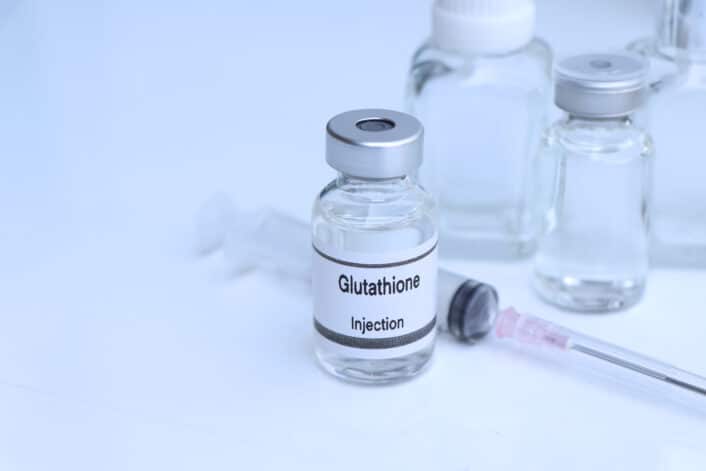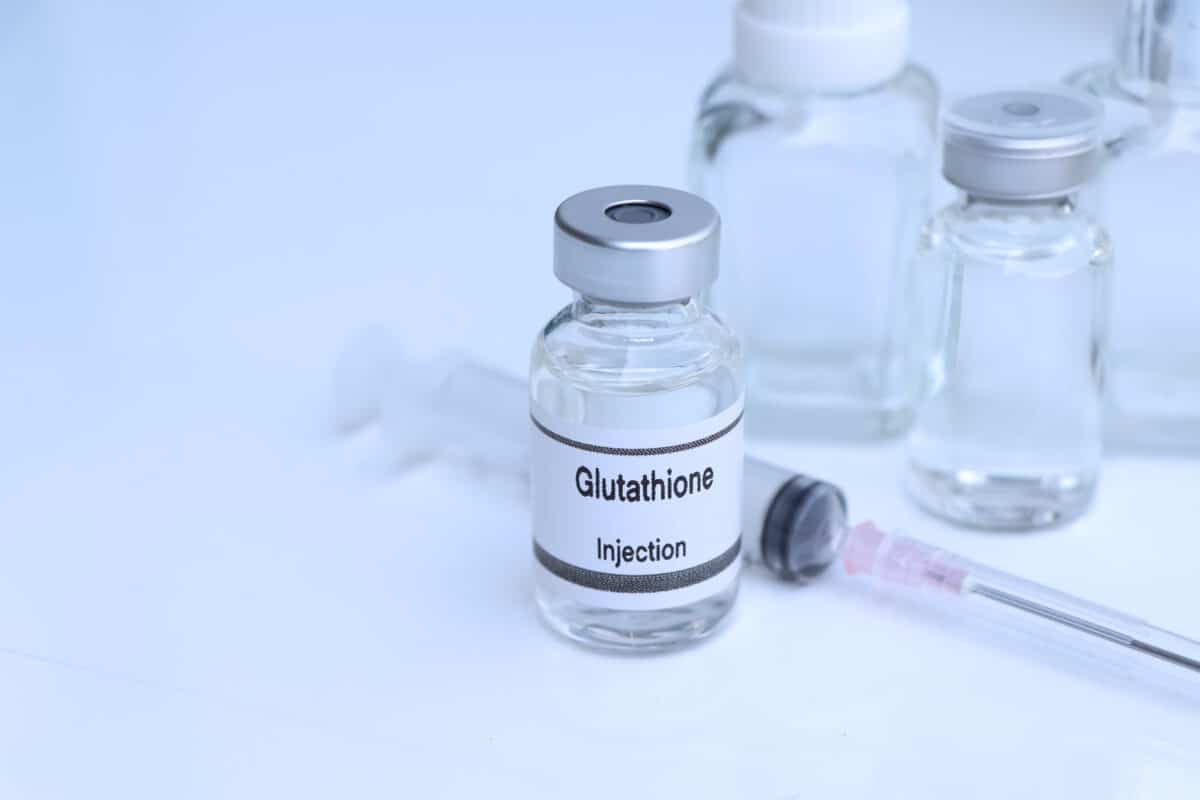How Genetics Shapes Your Body’s Use of Glutathione
Catherine
on
February 10, 2025

Disclaimer: This article is for informational purposes only and is not intended to diagnose any conditions. LifeDNA does not provide diagnostic services for any conditions mentioned in this or any other article.
Glutathione has gained global attention for its powerful antioxidant properties and its role in skin lightening, detoxification, and overall health. However, not everyone experiences the same results. But have you ever wondered why it works wonders for some people while others barely notice a difference?
The answer may come down to genetics. Our bodies rely on specific genes to produce, absorb, and regulate glutathione. Some people’s genetic makeup allows them to process it efficiently, leading to noticeable benefits, while others may struggle to absorb or activate it properly. Research backs this up—one study found that only 37.5% of patients saw visible results from intravenous glutathione therapy, and the effect faded over time.
Understanding how genetics influences your body’s response to glutathione can help personalize treatment, maximize benefits, and reduce risks. Could your DNA be the key to making glutathione work better for you?
What Is Glutathione?
Glutathione is a powerful antioxidant that helps protect the body from damage and keeps cells healthy. It is made of three building blocks called amino acids—glutamine, glycine, and cysteine. Unlike most antioxidants that come from food, our body can make glutathione in the liver.
Glutathione has many important jobs. It helps the body get rid of harmful substances, strengthens the immune system, and protects cells from damage that can lead to aging and disease. It also helps other antioxidants, like vitamins C and E, work better. The body needs glutathione for making DNA, helping enzymes function properly, and breaking down fats in the liver.
When glutathione levels are low, it may increase the risk of health problems like liver disease, diabetes, and a weaker immune system. The body naturally makes glutathione, but things like aging, stress, unhealthy food, and exposure to toxins can lower its levels. Eating foods rich in sulfur, like garlic, onions, and broccoli, can help boost natural glutathione production.
Genetic and Environmental Factors in Glutathione Regulation
Cells need a balanced amount of glutathione to stay healthy and fight damage caused by stress, which contributes to aging. A study on yeast shows that cells must carefully control how they produce, store, and use glutathione. If too much glutathione is lost, either by being sent out of the cell or not stored properly, cells become weaker and more vulnerable to stress. Research on yeast reveals that cells naturally cycle glutathione between the inside and outside, meaning they release and reabsorb it to regulate levels. When this process is disrupted, glutathione accumulates outside the cell, which may weaken its ability to protect against stress and damage.
A major finding is that vacuoles, which in yeast act like storage and recycling centers (similar to lysosomes in human cells), help regulate glutathione levels. This ties into the mTOR pathway, which controls how cells respond to nutrients and stress. It also found that nitrogen, an important nutrient, affects glutathione levels, suggesting that mTOR might help manage the body’s antioxidant defenses.
Another important finding is that potassium and sodium levels impact how cells store and release glutathione. Since aging is linked to problems with ion balance and energy production in cells, this could be important for understanding how to slow aging. Rapamycin, a drug that inhibits mTOR, is known to help cells clean out waste and handle stress better. The yeast study suggests that keeping glutathione levels stable may be a key way that mTOR inhibitors like rapamycin support healthier aging.
Further Genetic Studies on Glutathione
Another study explores how genes related to glutathione affect lung development in children exposed to polluted air. Glutathione helps protect the lungs from pollution and inflammation, which can cause long-term damage.
Researchers studied over 2,000 children across 12 cities in Southern California, measuring their lung function more than 14,000 times. They focused on four genes (GSS, GSR, GCLM, and GCLC) involved in glutathione production to see if certain genetic variations made some children more sensitive to air pollution.
The study found that changes in the GSS gene made some children more vulnerable to pollution. Those with a certain version of the gene had slower lung growth when exposed to pollutants like nitrogen dioxide (NO2) and fine particles (PM10, PM2.5). Their lung capacity, measured by tests like FEV1 and FVC, was lower compared to children without this gene variation. However, for ozone (O3), the opposite was true—children without this gene version showed worse lung effects.
This means a child’s genes can influence how much pollution harms their lungs. Some children may be more at risk for lung problems due to their genetic makeup, while others may be more protected. Understanding how genes influence stress responses could help develop strategies to support cellular health.
The Benefits of Glutathione
Serves as a Powerful Antioxidant: Glutathione protects the body from damage caused by free radicals, which can speed up aging and lead to diseases like cancer and heart problems. It acts like a shield for cells, keeping them healthy and reducing inflammation.
Boosts Immune System: Glutathione helps the body fight off germs by making immune cells stronger. It also keeps inflammation in check, which helps prevent the immune system from overreacting and attacking healthy cells.
Supports Liver Detox: The liver uses glutathione to remove toxins, heavy metals, and harmful chemicals. This helps protect the liver from damage caused by alcohol, medications, and pollution, keeping it working properly.
Helps Control Blood Sugar: Glutathione improves how the body uses insulin, which helps keep blood sugar levels stable. People with diabetes or insulin resistance often have low glutathione levels, so increasing it may help prevent complications.
Protects Brain Health: Glutathione helps protect the brain from damage that may lead to memory loss, Parkinson’s disease, and Alzheimer’s. It reduces harmful buildup in brain cells, supports memory, and keeps the brain working well.
Improves Skin Health: Glutathione may help brighten skin and reduce dark spots by slowing down melanin production. It also protects the skin from sun damage and aging, helping it stay smooth and healthy.
Supports Gut Health: Glutathione helps protect the gut lining and reduces inflammation linked to digestive issues like Crohn’s disease and ulcerative colitis. This may help ease symptoms and improve digestion.
Natural Ways to Get Glutathione
While the body naturally produces glutathione, factors like aging, stress, poor diet, and environmental toxins may lower its levels. Fortunately, there are natural ways to boost glutathione production and maintain optimal levels for overall health.
Eating sulfur-rich foods: Sulfur helps the body make glutathione. Foods rich in sulfur, like mushrooms, meat, eggs, fish, rice, bread, pasta, onions, garlic, broccoli, kale, and cabbage, can support this process. Research suggests that eating steamed broccoli may boost glutathione-related enzymes and help the body fight oxidative stress. However, more studies are needed to confirm these benefits.
Dairy products: Particularly those containing A2 beta-casein, may help boost glutathione levels. A study found that individuals who consumed A2-only dairy had higher plasma glutathione concentrations compared to those who had A1 and A2 dairy combined. Whey protein, another dairy-based source, is rich in cysteine and has been linked to increased glutathione levels in certain studies. If well-tolerated, incorporating A2 dairy or whey protein into the diet may help maintain glutathione levels.
Regular exercise: This is an effective way to enhance glutathione levels naturally while reducing oxidative stress. A study found that older adults who exercised regularly had higher glutathione levels, and even those who were previously inactive saw an increase when they started exercising. A combination of aerobic, strength, and flexibility training can help maintain long-term antioxidant balance and overall health.
Reducing toxin exposure: To keep glutathione levels healthy, it’s important to avoid things that lower it. Smoking, too much alcohol, processed foods, air pollution, and heavy metals can lower glutathione and increase stress on the body. Reducing exposure to these and using air purifiers when needed can help protect your body’s natural defenses.
It is important to note that more research is needed to fully understand long-term effects, current evidence suggests that these habits contribute to better health and improved resistance against oxidative stress.
Side Effects of Glutathione
While glutathione is generally considered safe, there is limited research on its potential side effects. In rare cases, adverse reactions have been reported, particularly with injectable forms. Below are some possible side effects and their explanations:
- Nausea and Vomiting: Some individuals may experience stomach discomfort, leading to nausea or vomiting after taking glutathione, especially in high doses.
- Lightheadedness: A drop in blood pressure or changes in circulation may cause dizziness or lightheadedness.
- Body Aches and Chills: Some people report flu-like symptoms, including muscle aches and chills, which may be linked to immune system reactions.
- Low Blood Pressure: Glutathione may affect vascular function, leading to a temporary drop in blood pressure, which can cause weakness or dizziness.
- Difficulty Breathing: In rare cases, glutathione injections have been linked to respiratory issues, making it important for individuals with asthma or lung conditions to use caution.
In 2019, the FDA issued a warning about a specific glutathione powder due to contamination with endotoxins, which can trigger these side effects. It’s important to choose high-quality glutathione supplements and consult a healthcare professional before use.
Precautions of Glutathione Supplementation
While glutathione supplements can support antioxidant function, they are not suitable for everyone. Here are some important precautions to consider:
- Individuals with Asthma: Some research suggests that inhaled glutathione may cause bronchial constriction, potentially triggering breathing difficulties in people with asthma.
- Medication Interactions: Glutathione may interact with certain medications, including chemotherapy drugs and diabetes medications, possibly affecting their effectiveness.
- Overuse and Imbalances: Excessive glutathione supplementation may interfere with natural detox pathways, potentially leading to imbalances in the body’s antioxidant system.
- Quality and Contamination Risks: Since glutathione supplements are not tightly regulated, low-quality products may contain harmful additives or contaminants, such as endotoxins.
- Limited Research on Long-Term Use: There is still a lack of large-scale studies on the long-term effects of glutathione supplementation, so its safety over extended periods remains uncertain.
Before starting glutathione supplements, it’s best to consult a healthcare provider, especially for individuals with preexisting health conditions or those taking medications.
References
- https://pmc.ncbi.nlm.nih.gov/articles/PMC539166/
- https://pmc.ncbi.nlm.nih.gov/articles/PMC3040392/
- https://www.ijced.org/html-article/22694
- https://www.webmd.com/vitamins/ai/ingredientmono-717/glutathione
- https://www.medicalnewstoday.com/articles/326196#dairy
- https://www.medicalnewstoday.com/articles/323936



















